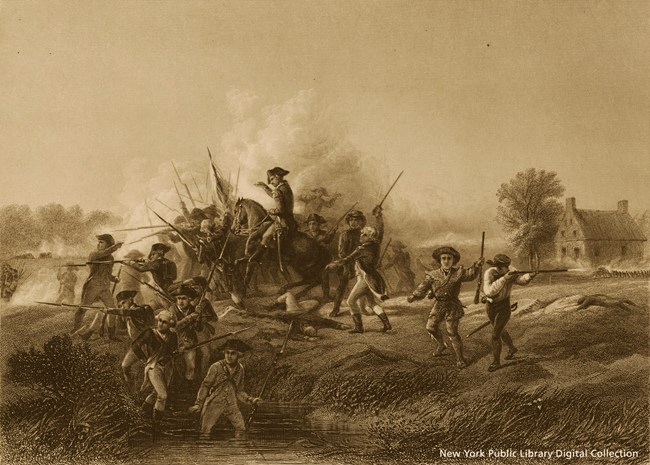Last updated: August 24, 2021
Article
The Maryland 400

New York Public Library Digital Collection
Fortunately, a month before, the First Maryland Regiment had already left for New York, Maryland’s most disciplined and well-equipped force. Many of the Marylanders even had bayonets for their weapons, which others in the Continental Army lacked. Bayonets turned muskets into spears for close contact fighting. The regiment was under the command of Colonel William Smallwood with the assistance of Thomas Stone’s brother, Captain John Hoskins Stone. By late August, the First Maryland Regiment, totalling about 1,100 men was positioned in the vicinity of Brooklyn on Long Island.
While George Washington was an able and skilled commander, his task would be extremely difficult; trying to determine exactly where the British would land, and not having enough men to defend every area. Added to that, he made several significant mistakes in the lead up to the Battle of Brooklyn. He divided his forces between Manhattan, where he expected the main British attack, and Long Island. Even after the British landed 10,000 infantrymen on Long Island, Washington did not move to support the Marylanders and other American forces on Long Island.
Early on August 27, 1776, a column of several thousand British soldiers under the command of Generals Cornwallis and Clinton marched through the barely defended Jamaica Pass on Long Island. At 9:00 am, the British commenced an attack on the Americans from the rear, while Hessian (German) mercenaries attacked from the front.
In the battle, Colonel William Smallwood was not with the First Maryland Regiment, instead assisting in a court martial proceeding. General William Alexander, self-proclaimed as Lord Stirling, took command of the Marylanders and the First Delaware Regiment.
As the morning progressed, the enemy began to encircle the Americans. The only possible escape route was to cross under heavy fire, a marshy area about eighty yards wide called Gowanus Creek. On the other side was the stronger American position of Brooklyn Heights. Lord Stirling ordered most of his men towards the Gowanus Creek, and about half the First Maryland Regiment and most of the First Delaware Regiment was able to retreat, including Stone’s first company. Stirling stayed with about 400 battle-weary Maryland and Delaware survivors to serve as a rear guard.
Two thousand British infantrymen and Hessians surrounded the Marylanders and Delawareans. Many of the British fired from the windows of a building known locally as the “Old Stone House.” In the smoke and confusion of battle the house must have looked like a fortress. Then Lord Stirling and the “Maryland 400” did the unexpected. They charged towards the Old Stone House with their muskets and bayonets.
According to survivor accounts, the British “infantry poured volleys of musket balls in almost solid sheets of lead” at the Marylanders and Delawareans. Forced to retreat, they regrouped over their dead and wounded friends and colleagues and charged a second time with their fixed bayonets. Then they did it a third time.
When the fighting was ended, 256 Marylanders and Delawareans lay dead on the ground in the vicinity of the Old Stone House, over 60% of the attacking force and one of the largest fatality percentage rates for any battle in American history. Over 100 were captured, but many of those Marylanders and Delawareans died as prisoners of war. Only a few dozen of the “Maryland 400” escaped alive back to American lines.
One of those survivors was brilliant and ever-proud Lord Stirling, who refused to surrender to the British that surrounded him. Instead, he slipped past these foes and surrendered to a group of Hessian mercenaries.
Captain John Hoskins Stone would later fight alongside the men of the Maryland Line in the battles of Trenton, Princeton, Brandywine, and Germantown. A bone shattering battle wound in his ankle at Germantown in October 1777 left him lame for the rest of his life.
The significance of the "Maryland 400" cannot be understated. The intense fighting near the Old Stone House lasted almost an hour, which allowed many Americans to escape with their lives. More importantly, it halted the British offensive for the day, which otherwise may have led to the capture of General Washington and his army. The sacrifice of the "Maryland 400," although a more apt term should be the "Maryland and Delaware 400," quite possibly saved the Revolutionary War.
